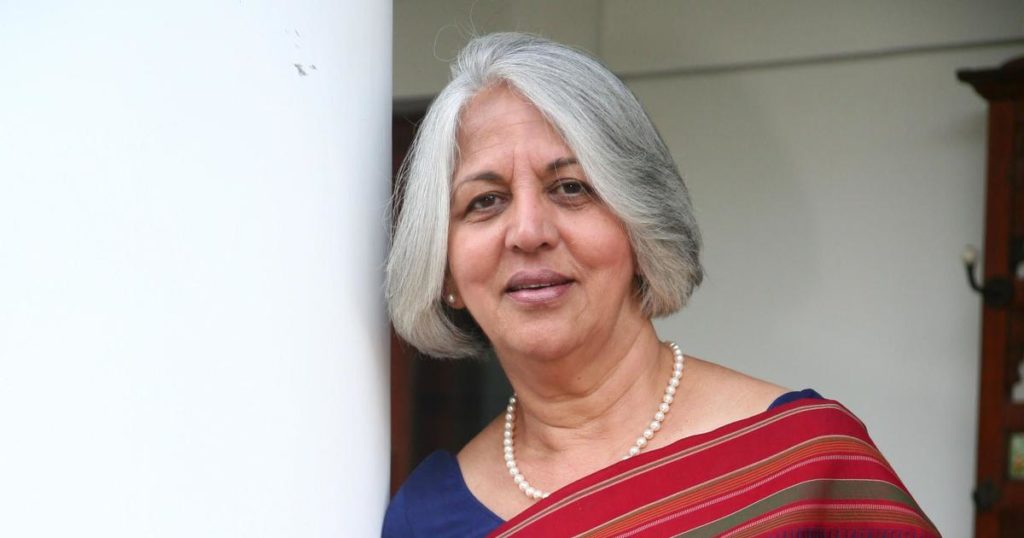Review of Breaking Through by Vinay Sitapati at Scroll
A financial journalist, the story goes, called up the residence of Montek Singh Ahluwalia, at the centre stage of economic policy from the 1980s to 2014. These were, not coincidentally, the growth years of the Indian economy, and Ahluwalia was the go to person for businessmen, academics, foreign diplomats, politicians, and of course, journalists.
“Can I speak to Dr Ahluwalia?” the journalist asked. A woman’s voice replied: “Speaking”. The puzzled journalist then asked: “Can I speak to the other Dr Ahluwalia?”. There was silence on the other end. “There is only one Dr Ahluwalia in this house”, the woman replied, and put down the phone.
This story is oft-repeated precisely because it captures what is widely believed to be Isher Judge Ahluwalia’s role in the defining marriage of Indian economic policy. She was after all the brilliant student from India who did a PhD in the world’s best economics programme (MIT) with the world’s best economist (Paul Samuelson). Her research on the lack of economic productivity in India’s licence-quota-permit-raj had made her a much-cited scholar.
In contrast, her bureaucrat husband Montek Ahluwalia was more babu than brain, more builder than architect. Montek Ahluwalia may have spent three decades on Raisina Hill advocating the policies that would open India, but the ideas behind those policies can be traced to his better half.
This was the story I expected to read when I got a first draft of Breaking Though, the memoir of Isher Ahluwalia, who died on the morning of September 26. (Full disclosure: this is partisan review; I am a family friend of the Ahluwalias.) I expected to wade through dense economic jargon. I was not looking forward to it.
Was I surprised at what I read!
Making it in a man’s world
Rather than a boring tome on fiscal deficits, Breaking Through is the personal memoir of a Hindi-medium-type making it to the dazzling, Anglophone world of economic policy. Much before Kangana Rannaut had set the clubby world of Bollywood on fire, Isher Ahluwalia was breaking through in her own way, armed with as much verve (and much more scruple). Isher’s is the story of a woman making it in a man’s world – having to juggle the demands of academic research, raising a family, a high-flying husband, all while still relishing life.
These, really, are the two themes of the book. The first, on the social world of Indian economist-policy makers, is a must read to understand the ideas that kept India poor through the licence raj (especially the 1960s, ’70s, and ’80s). It also helps identify the new breed of economic thinkers whose home-grown ideas have moved millions out of poverty since the 1990s. Isher is at the heart of these worlds, old and new.
As an undergraduate at Presidency College in Calcutta, she is taught by Bimal Jalan (a future Reserve Bank governor). As a student at the Delhi School of Economics, she encounters Amartya Sen and Manmohan Singh. Her fellow-student, the pioneering Marxist economist Utsa Patnaik, even lent the cash-strapped Isher some money. And at MIT in the US, she looks at fall colours with those who will soon man the ramparts of Indian economic policy. While she underplays her own academic talent, she puts her finger on the problem of Indian economic thinking in the 1960s and ’70s – students were being taught outdated ideas distanced from the cutting edge of the discipline.
The second theme of Breaking Through is as illustrative. This is a story of a feisty Punjabi woman unwilling to take no for an answer. It’s the story of someone whose academic ambitions must always be balanced by the need to raise two children. All the while, she must ensure that no shadow befalls her husband while he rises within the bureaucracy. Through it all, she retains her punchiness. When offered a job in the government she refuses, while making sure to point out she has been offered a post more junior than the one her husband had at that age.
Friends and no villains
The Ahluwalias’ battles to get the state out of the market must have been a bloody one. As Isher points out in Breaking Through, she was even smeared with the canard of being a “CIA agent” – as wounding an insult during socialist India as “anti-national” is in Modi’s India. In writing and researching thus, Isher went against the grain of the Left-leaning institutions that produced her. Yet, Isher does not tell us how she was able to win the battle of ideas, especially in the 1980s. It is a notable omission.
Breaking Through also cleverly short of villains. Isher seems to have only friends and supporters, no enemies. Her only criticism seems reserved for her own mother-in-law, who saw Isher as an upstart from a lowly family. This technique of not rubbing people the wrong way – also visible in Montek Ahluwalia’s memoirs released a few months ago – makes for a less masaledaar book. But it explains why the Ahluwalias were such successful proselytisers of the ideas that liberated India.
While commenting on her first draft, I requested Isher to write in detail on the UPA years, on the tensions between prime minister Manmohan Singh and Congress president Sonia Gandhi. I nudged her to blame the latter. Readers will like it, I argued, as will Arnab Goswami. It also had the virtue of being true. Isher refused. She was loyal to Manmohan Singh, and Manmohan was loyal to Sonia. Matter closed.
Isher could have identified a more convenient villain. The policymakers whom Isher chronicles – homegrown intellectuals who knew Indian reality as well as world economics – have been ignored by the current government. Their crime: closeness to the Congress, a professional streak, and an English-speaking background. A case can be made that the failure to harness these policy-makers has caused India’s disastrous economic performance in the Modi years. But Isher refuses to make even this case.
The absence of bitchy revelation might strike readers as a prerequisite to survive this long in the jungle of Lutyens Delhi. But it is perhaps the book’s ultimate revelation. Isher Ahluwalia has not spent her life making a hit-list of those who have wronged her. Instead, she thanks god (she comes across as quite religious) for opportunities given and talents bestowed. In these rancorous times, this itself seems like a breakthrough.

The reviewer, Dr Vinay Sitapati (Ph.D. Princeton), is Assistant Professor of Political Science & Legal Studies, Ashoka University, India, where he is also the Head of the Department of Political Science. He has additional degrees from National Law School Bangalore and Harvard University. His work has appeared in publications as diverse as the Economic & Political Weekly, International New York Times, The Indian Express, Harvard BlackLetter Law Journal, The Hindu, Harvard Crimson, Oxford Handbook of the Indian Constitution, and Seminar.
His first book was a best-selling biography of Indian prime minister P.V. Narasimha Rao: Half-Lion. Published in India by Penguin Books and in the United States by Oxford University Press-USA, the book has been translated into Hindi, Tamil, and Telugu. The Economist magazine termed it a ‘Book of the Year’, and it is part of Amazon.com‘s ‘100 books to read in a lifetime’.
His second book, The BJP Before Modi, will be published in late 2020 by Penguin Books. It is being translated into Hindi, Telugu, and Marathi, and is currently under peer review with an academic press in the United States.
This review is included here by permission; it was originally published by Scroll.in at https://scroll.in/article/974031/how-isher-judge-ahluwalia-broke-into-the-male-dominated-anglicised-world-of-economists
Our thanks to Scroll as well as to Dr. Sitapati.


